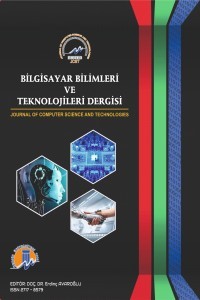Zaman Pencereli Evde Bakım/Beslenme Hizmeti Yönlendirme Problemi İçin Karınca Koloni Algoritması
Evde Bakım, Optimizasyon, Araç Rotalama, Karınca Koloni Algoritması
Ant Colony Algorithm For Household Care / Nutrition Service Direction Problem With Time Window And Fuzzy Demand
Household Care, Optimization, Vehicle Routing, Ant Colony Algorithm,
___
- Blum, C., & Roli, A. (2003). Metaheuristics in Combinatorial Optimization: Overview and Conceptual Comparison. ACM Computing Surveys, 35(3), 268–308.
- Çetin, S., & Gencer, C. (2010). Kesi•n zaman pencereli• - Eş zamanli daǧitim toplamali araç rotalama problemi•: Matematiksel model. Journal of the Faculty of Engineering and Architecture of Gazi University, 25(3), 579–585.
- Cordeau, J. F., Gendreau, M., Laporte, G., Potvin, J. Y., & Semet, F. (2002). A guide to vehicle routing heuristics. Journal of the Operational Research Society, 53(5), 512–522.
- De Backer, B., Furnon, V., Shaw, P., Kilby, P., & Prosser, P. (2000). Solving vehicle routing problems using constraint programming and metaheuristics. Journal of Heuristics, 6(4), 501–523.
- Deneubourg, J. L., Aron, S., Goss, S., & Pasteels, J. M. (1990). The self-organizing exploratory pattern of the argentine ant. Journal of Insect Behavior, 3(2), 159–168.
- Dorigo, M., Di Caro, G., & Gambardella, L. M. (1999). Ant algorithms for discrete optimization. Artificial Life, 5(2), 137–172.
- Dorigo, M., & Gambardella, L. M. (1997). Ant colony system: A cooperative learning approach to the traveling salesman problem. IEEE Transactions on Evolutionary Computation, 1(1), 53–66.
- Goss, S., Aron, S., Deneubourg, J. L., & Pasteels, J. M. (1989). Self-organized Shortcuts in the Argentine Ant. Naturwissenschaften, 76(1959), 579–581.
- Keskintürk, T., & Söyler, H. (2006). Global Karınca Kolonisi Optimizasyonu. Gazi Üniversitesi Mühendislik Mimarlık Fakültesi Dergisi, 21(4), 689–698.
- Nabiyev, V. (2003). Yapay Zeka - Problemler, Yöntemler, Algoritmalar. Seçkin Yayınevi.
- Oesterle, J., & Bauernhansl, T. (2016). Exact Method for the Vehicle Routing Problem with Mixed Linehaul and Backhaul Customers, Heterogeneous Fleet, time Window and Manufacturing Capacity. Procedia CIRP, 41, 573–578.
- Reimann, M., Doerner, K., & Hartl, R. F. (2004). D-ants: Savings based ants divide and conquer the vehicle routing problem. Computers and Operations Research, 31(4), 563–591.
- Şahin, Y., & Eroğlu, A. (2014). KAPASITE KISITLI ARAÇ ROTALAMA PROBLEMI IÇIN METASEZGISEL YÖNTEMLER: BILIMSEL YAZIN TARAMASI. Süleyman Demirel Üniversitesi İktisadi ve İdari Bilimler Fakültesi Dergisi, 19(4), 337–355.
- Stützle, T., & Hoos, H. H. (2000). MAX-MIN Ant System. Future Generation Computer Systems, 16(8), 889–914.
- ISSN: 2717-8579
- Yayın Aralığı: Yılda 2 Sayı
- Başlangıç: 2020
- Yayıncı: Mersin Üniversitesi
Mathematical Modeling of Cyber Attack and Defense
Sonlu elemanlar yöntemi kullanılarak endüstriyel robot kol analizi
Zaman Pencereli Evde Bakım/Beslenme Hizmeti Yönlendirme Problemi İçin Karınca Koloni Algoritması
Burak CAN, Prof. Dr. Hamza EROL
Türkiye’de Robotik Süreç Otomasyonu
Hatice ÖZDEM, Muazzez Pınar BORA
Bankacılık Sektöründe Yazılım Test Süreçlerinin Önemi ve Yöntemleri
